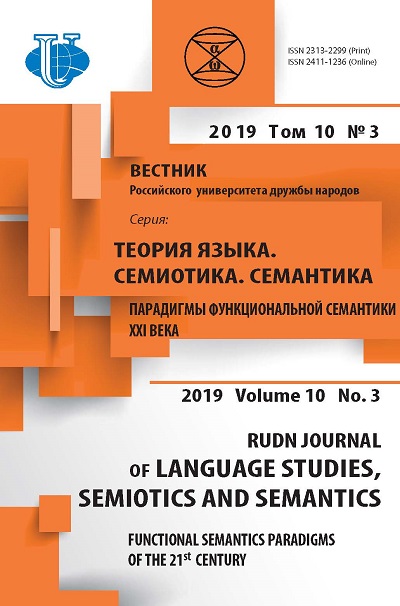Possibility of Semantic Transformation of Proper Names in the German language
- Authors: Chigasheva M.A1
-
Affiliations:
- Moscow State Institute of International Relations (MGIMO-University)
- Issue: Vol 10, No 3 (2019): Functional Semantics Paradigms of the 21st century
- Pages: 644-652
- Section: LEXICO-SEMANTIC TRANSFORMATIONS: FROM WORD TO TEXT ↔ FROM TEXT TO WORD
- URL: https://journals.rudn.ru/semiotics-semantics/article/view/22122
- DOI: https://doi.org/10.22363/2313-2299-2019-10-3-644-652
- ID: 22122
Cite item
Full Text
Abstract
This article presents a brief overview of the language means of the German used in modern media discourse. Currently, the role of political communication, mediated by media discourse, is becoming increasingly important and attracting more and more attention of linguists. The language of the media is dynamic, imaginative, expressive, at the same time it is subject to the general principles of the functioning of the language system. A good example of this is the use in the texts of German-language online editions of the names of proper and derived lexical units. The focus is on deonyms, formed from the names of famous political figures of Germany and Austria. The results of the analysis show that proper names have an associative potential; in the process of use in speech, they can undergo semantic changes, lose touch with the designation of a specific person, and become a derivational basis for new lexical units. Thus, in the German language, thanks to the structure of anthroponyms and typical word-formation models, there appear deonyms-verbs, deonyms-participles, deonyms-adverbs, deonyms-adjectives, deonyms-nouns. They are designed to perform suggestive and manipulative functions in media discourse. This language phenomenon is of interest from the point of view of cognitive science, semantics, translation studies, comparative linguistics.
About the authors
Marina A Chigasheva
Moscow State Institute of International Relations (MGIMO-University)
Author for correspondence.
Email: mchigasheva@mail.ru
Ph.D. in Philology; Associate Professor, Head of the Department of German in Faculty of the International Relations
Moscow, RussiaReferences
- Edlichko, A.I. (2016). Zur Euphemisierung von Ethnonymen im Deutschen [Revisiting the Euphemization of Ethnonyms in German]. Vestnik MGU. Seriia 19: Lingvistika i mezhkul'turnaia kommunikatsiia, No. 3, pp. 134—148. (In Germ.).
- Gataullin, R.G. (2015). New Eponymic Verbs in Modern German Language. Vestnik Bashkirskogo universiteta, 20 (4), 1304—1310. (In Russ.).
- Tamerian, T.Yu. & Tsagolova, V.A. (2019). Dynamics of metaphorical verbalization of the image of Kanzlerin Angela Merkel. RUDN Journal of Language Studies, Semiotics and Semantics, 10 (1), 141—151. (In Russ.).
- Tameryan, T.Yu. & Tsagolova, V.A. (2014). Metaphorical Modeling of the German Chancellor A. Merkel’s Image. Kommunikativnye issledovaniia, 2, 70—78. (In Russ.).
- Reformatskij, A.A. (2001). Introduction to Linguistics. Moscow. (In Russ.).
- Glushak, V.M. Mutual perception of Russians and Germans from antiquity to the present day. Moscow. (In Russ.).
- Digitales Wörterbuch der deutschen Sprache. URL: https://www.dwds.de (accessed: 15.06.2019).
- Superanskaja, A.V. (1973). General Theory of Proper Name. Moscow. (In Russ.).
- Wengeler, M. Zwinglisch, Marxismus, Genschern (2000). Deonomastika aus Personennamen im Deutschen. Muttersprache 110, 4, 289—307. (In Germ.).
- Wengeler, M. Schaubleweise, Schröderisierung und Riestern. (2010). Formen und Funktionen von Ableitungen aus Personenamen im öffentlichen Sprachgebrauch. Komparatistik Online. Düsseldorf, Trier, 79—98. URL: http://www.komparatistik-online.de (accessed: 20.05.2019). (In Germ.).
- Sternin, I.A. (2001). Introduction to speech exposure. Voronezh. (In Russ.).
- Nikitina, O.A. (2015). Peculiarities of New German Verbs Formation Based on Anthroponyms. Nauchnyi dialog, 11 (47), 42—54. (In Russ.).
- Duden Online Wörterbuch. URL: www.duden.de/rechtschreibung/hartzen (accessed: 15.06.2019). (In Germ.).
Supplementary files












